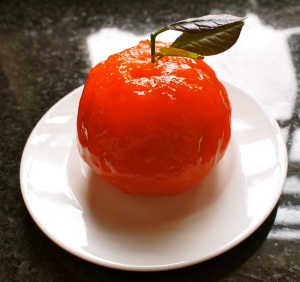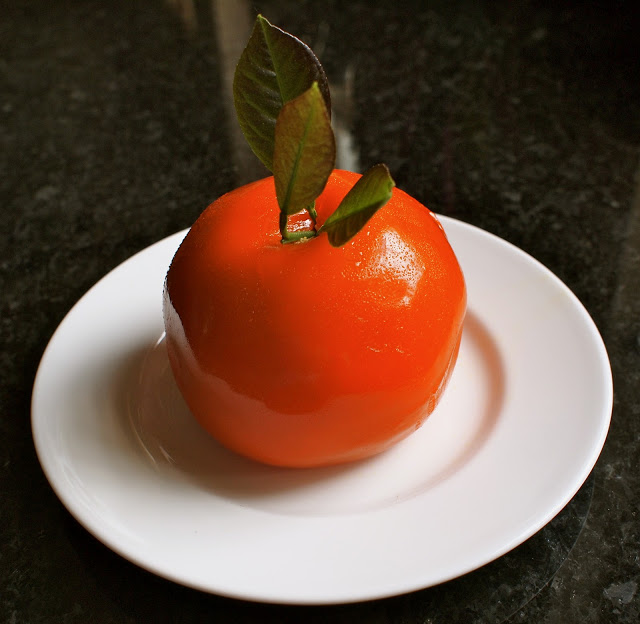I recently had dinner at Dinner, by Heston Blumenthal. For various reasons the Hubby and I weren’t actually going to order “Meat Fruit”, but the kitchen sent us one, and we were completely blown away by the texture of the parfait, and the contrasting acidity of the jelly. The dish is light, but rich, moreish, very slightly palate cleansing – and yes – I accept that those are complete contradictions. It’s the mandarin jelly – it really does release something in the palate that allows the very rich parfait to not become overly cloying.
When I wrote my restaurant review I searched for the recipe, intrigued about how it was made – everyone knows I’m a complete sucker for a culinary challenge :0)
Not only did I found the actual recipe given to the Guardian by Heston, but I also found a tiny bit of video clip which showed it being dipped, a video blog by a Thermomix blogger, and a variation by the Cumbrian Foodie on his blog. I suggest you look at them all. If you’re serious about making this at home, it’s worth making the parfait a week or so before you need it, and perhaps doubling the quantify to allow you time to play with the jelly dipping. All of the procedures up to the jelly are incredibly easy – do give it a go – it’s much easier than it might seem.
Key stages and timings:
- Put the marinade ingredients together, leave for 24 hours
- Make the chicken liver parfait, leave for 24 hours
- Put the parfait into the moulds, and freeze until solid (6 hours maybe?)
- Assemble the two halves of the parfait ‘sphere’, and refreeze (1 hour maybe?)
- Dip the spheres into the mandarin jelly, then leave to defrost in the fridge for 6+ hours
100g shallots, finely sliced
3g minced garlic
15g sprigs of thyme, tied with string
150g dry Madeira
150g ruby port
75g white port
50g brandy
18g table salt
400g chicken livers (trimmed weight)
240g eggs
300g unsalted butter, melted
- Place the shallots, garlic and thyme in a saucepan with the Madeira, ruby port, white port and brandy. Set aside to marinate for 24 hours.
- Heat the marinated mixture until nearly all the liquid has evaporated, stirring regularly to prevent the shallots and garlic from burning. Remove from the heat and discard the thyme.
- Preheat the oven to 100C/gas mark ¼. Fill a bain-marie with 5cm water and place in the oven.
- Preheat a water bath to 50C.
- Sprinkle the table salt over the livers and put them in a sous-vide bag. Put the eggs and the alcohol reduction in a second sous-vide bag, and the butter in a third. Seal all the bags under full pressure, then place in the water bath for 20 minutes. Remove the bags from the water bath.
- Combine the eggs, alcohol reduction and meat in a Thermomix and blend until smooth at 50C. Slowly blitz in the butter and blend until smooth. Pass the mix through a fine sieve using the back of a small ladle.
- Pour into a terrine dish and place in a bain-marie and cover the bain-marie with aluminium foil. Cook the parfait until the temperature in the centre reaches 64C.
- Remove from the oven and allow to cool. Refrigerate for 24 hours before serving.
For the mandarin jelly:
500g mandarin purée (I used half a pack of Boiron’s mandarin purée)
80g glucose
0.4g mandarin oil
1.5g paprika extract (the paprika is to colour the gel – instead I used a specialist cake decorating gel, in egg yolk yellow)
- Place the gelatine in cold water to soften.
- Gently heat the mandarin purée and glucose in a pan to combine.
- Add the softened gelatine and stir well until dissolved.
- Remove from the heat and add the mandarin oil and paprika extract and stir well.
- Pass the mix through a fine sieve and reserve in the fridge until required.
To make the fruits:
- Using a spoon, fill dome moulds with parfait, ensuring there is enough pressure to create a completely smooth surface. Level off the tops so that they are flat, and cover with cling-film. Gently press the clingfilm directly onto the surface of the parfait. Place in the freezer until completely frozen. (if you put half the moulds onto a flat tray, you can achieve a slightly inverted dip on top of the fruit – see my photograph below)
- Gently de-mould the parfait domes. Place on a board with the flat sides facing upwards. Very briefly run the flame of a blow torch over the flat side, being careful only to just melt the surface of the parfait. Join two halves together and compress using a square of cling-film. Wrap well in cling-film and place back in the freezer until required.
- Gently push a wooden cocktail stick into the middle of the rounded surface and re-wrap until all the parfaits are complete.
- Gently melt the mandarin jelly in a saucepan and allow to cool to room temperature. Remove the cling-film and dip each ball of parfait into the jelly and stand the sticks, covered in cling-film, into a piece of Oasis (the green material you get in florist shops to help the flowers stand up). Place in the fridge for a minute, then repeat the dipping process.
- Dip three times, then gently remove the cocktail stick and place the balls onto a tray covered in cling-film. Place a lid over the tray and leave in the fridge to defrost for at least six hours.
- Once defrosted, gently push the top of the ball using your thumb to create the shape of a mandarin. Place a stalk and leaf in the top centre of the indent to complete the fruit.
Not this is the point where I show you a perfect meat fruit, the one I prepared earlier… But I don’t want to do that just yet :0) Instead here are the things I’ve learnt, which you might like to consider, with photo’s to illustrate the points. After all what’s the point of blogging if we don’t share our experiences?
So, example 1. If the parfait ball is too smooth to start off with, the resulting mandarin looks somehow quite fake. I took to roughing up the parfait slightly in the cling-film with my hands before dipping it. Also in this example, the jelly was definitely too warm – I thought it was room temperature, it wasn’t. At this point I decided to take one parfait and dip it every ten minutes. As a result this parfait sat on the side for over half an hour, and you can see that effectively defrosting it at room temperature causes the shape to slump. There’s still not quite enough colour in the gel to cover all the flaws (you can’t see it as well here, because I re-dipped it), but I had to boost the colour to a practically fluorescent orange colour – you’re not looking for natural – you really are looking for an unnatural intensity. You can see all of the above in the photograph.
 |
| “Too Smooth” Meat Fruit |
In this next example the jelly was far too cool, and it set around the parfait instantly in a slightly monstrous and lumpy version of the skin! Amusing though – we thought this one was great fun. It may look as though you can get away with this, but bear in mind it will have a very thick jelly coating!
 |
| “Monster” Meat Fruit |
In the next example we whisked the jelly until it was smooth again and a fraction warmer, and then repeated… This was among the better examples.
 |
| Meat Fruit |
I didn’t make many, but I think you can see that it’s the dipping that requires the work – everything else was easy. I have seen other examples where people just went with the smooth jelly, and if this is your preference, stick to it all the way through to ensure consistency.
The one good thing is that you can keep the parfait balls in the freezer until your ready – I think in future I’ll make everything up to that point at least a week in advance (and make more than I need), and then just keep them in the freezer until they’re required. Pate can be stored for up to a month in the freezer, so you could keep a batch on the go, as long as you date them appropriately.
Does it taste like the real thing? Well, it’s chicken liver and doesn’t have the fois gras included in the restaurant version, but I think it’s a pretty accurate recipe.
Update: I spoke to Ashley Palmer-Watts on twitter about the dipping process, and this was his advice:
@APWChef Not bad, just need to not rush at the end, let them re freeze between dips and keep the gel at a steady temp pic.twitter.com/aYfFe7cD
@Bebejax Ah, of course, hadn’t occurred to keep it constant! Don’t suppose you’d care to reveal the magic number?
@Bebejax Thanks! Will try it again and post pics! And yes, took the gel above 50, but was using gold
Now that you’re a Heston expert, don’t forget I have his lemon tart recipe on the blog, and for the more adventurous, I’ve just come across his snail porridge recipe! Yes. Good luck with that…

